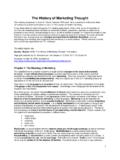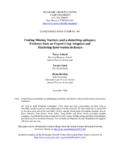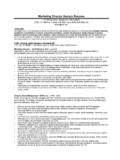Transcription of FRAGRANCE IN THE WORKPLACE IS THE NEW …
1 Proceedings of ASBBS Volume 16 Number 1. FRAGRANCE IN THE WORKPLACE IS THE NEW. second -HAND smoke . De Vader, Christy L. Loyola College in Maryland Barker, Paxson University of Maryland ABSTRACT. It took decades for the WORKPLACE to acknowledge the dangers of smoking and to recognize the deadly effects of exposure to second -hand smoke . Once acknowledged, it was a few more years before the WORKPLACE became safe for all workers from the dangers of second hand smoke . We propose in this paper that FRAGRANCE is following the same trajectory. To date most of the research on FRAGRANCE exposure has been localized in the health care profession and has not received the necessary attention it deserves in the management literature for managers to become knowledgeable about the extent of employer liability and what constitutes a good faith effort to protect workers. This paper serves as a much-needed bridge to fill this vital gap in managerial knowledge. Current laws ( , Americans with Disabilities Act, Workers Compensation, and OSHA regulations) are identified that can be applied to FRAGRANCE exposure.
2 The relevant laws and subsequent court cases are analyzed and the legal liability they create for employers with employees exposed to synthetic FRAGRANCE in the WORKPLACE are clearly identified. We also provide recommendations for organizations who want to demonstrate a good faith effort and be proactive to reduce or limit employees' FRAGRANCE exposure in the WORKPLACE , before being sued We present the results of several organizations that have some experience with addressing the issue in their workplaces and identify the lessons learned We conclude by recommending actions employers can take to proactively respond (react) to common situations of exposure that arise for employees with FRAGRANCE sensitivity. RESISTANCE TO WORKPLACE FRAGRANCE AND second -HAND smoke . The parallels between second -hand smoke and synthetic FRAGRANCE use are many. At its core, both are battles over indoor air quality. In the 1960's, when a few people began complaining about second -hand smoke and possible negative effects on health, the general public and business considered this a fringe movement that was unlikely to gain steam.
3 In 1965, of Americans over the age of 25 smoked (CDC, 2007). Smoking was the norm and even tobacco companies did not expect significant change to occur in public perception or behavior. smoke -free city ordinances date back to 1985 initiated by the city of Aspen, CO (Isaacs et al., 2006). This marked the beginning of dramatic change that culminated with at least 30 states and the District of Columbia passing comprehensive smoke -free laws by June 2007. (Rutkow, Vernick & Teret, 2007). In addition, many local governments and businesses have instituted smoking bans as of 2008 (Bosky, 2008). According to the American Nonsmokers' Rights Foundation, currently 50% or more of the US population lives in jurisdictions with restrictions on second -hand smoke . Similarly, non- FRAGRANCE companies that sell FRAGRANCE based products ( , cleaning products, polishes, and laundry products) are still largely unconcerned by the general public's increasing awareness that everyday products may be detrimental to their health.
4 The consumer is as uneducated about the dangers and health risks associated with constant exposure to the chemicals used in synthetic FRAGRANCE ASBBS Annual Conference: Las Vegas February 2009. Proceedings of ASBBS Volume 16 Number 1. products as the average non-smoker was to the risks of second -hand smoke . When ignorance is replaced with knowledge, a large segment of the population will respond with a demand for clean and safe air in the WORKPLACE . In the United States and Canada, an increasing number of clinics, schools, public buildings and meetings, buses and workplaces have declared their institutions FRAGRANCE -free: a paradigm shift is beginning. There are key differences between encounters with passive smoke and synthetic FRAGRANCE . Passive smoke is visible and easily identified as a by-product of someone smoking cigarettes or cigars in near proximity to others, whereas synthetic FRAGRANCE is a vapor that eludes identification. As used today, FRAGRANCE is almost unlimited in where it is found and is used in hundreds of everyday, personal care products.
5 Synthetic FRAGRANCE is not clearly defined by the manufacturer labels for the consumer to see because the FDA protects the use of FRAGRANCE under the provision of trade secrets established for the perfume industry many years ago (USFDA). Synthetic FRAGRANCE is added to many products to mask the odor of noxious chemicals contained in disinfectants and cleaning products. Manufacturers using synthetic FRAGRANCE need only include the word FRAGRANCE on the ingredients label to comply with the FDA trade secret standard. Because of these differences, businesses underestimate the potential likelihood of a FRAGRANCE free movement reaching the same level of public awareness as passive smoke and having as far reaching and broad results as the nonsmoking movement, which banned smoking in organizations and businesses at local and statewide levels. This could prove costly to all businesses, including businesses that produce synthetic FRAGRANCE based products, and businesses that only use synthetic FRAGRANCE or allow it into the WORKPLACE .
6 The American Nonsmokers' Rights Foundation released a largely unknown documentary, Death in the West , which showed the contrast between the advertising of Marlboro cigarettes as a sexy and an attractive lifestyle to be desired against the reality of actual cowboys dying of smoking- related diseases. Phillip Morris, a tobacco company, censored the documentary after its first airing in 1976 (ANR, 1976). This decisive, quick, and aggressive action to the movie was characteristic of tobacco companies'. responses to information about the dangers of passive smoke . FRAGRANCE companies are cautiously following their example. In Halifax, Nova Scotia, many of the public and private organizations went FRAGRANCE free over 10 years ago. Several retailers have noticed greater than a 30% drop in sales of perfume since the FRAGRANCE -free policies were implemented. Companies have responded in various ways, some have reduced the percentage of floor space devoted to perfume. Others have instituted policies that are reminiscent of the tobacco industry such as changing their marketing strategies and developing a new product mix though their responses are less confrontational than the tobacco industry.
7 For example, tobacco companies made their products more addictive, they marketed aggressively to other regions such as Asian markets, and focused their advertising to very specific segments. FRAGRANCE companies and associations are also changing their marketing strategies by creating pamphlets instructing people on how to wear scent. The Canadian Cosmetics, Toiletry, and FRAGRANCE Association developed such a pamphlet in 1999 titled, Enjoying Your FRAGRANCE . Instructions on how to wear FRAGRANCE seem to imply that there is a proper, correct, and safe way to wear perfume. Additionally, some companies are actively promoting unscented cosmetics. The inference is that, unscented cosmetics are FRAGRANCE free which is not always true. The two terms are not interchangeable which is what smokers found out when they changed to smokeless tobacco. Today a wide range of products are sold using the same general theme as the Marlboro ads: life is better;. and your clothes, body and house are cleaner, fresher, more desirable if they smell nice.
8 However, the invisible and unlabeled ingredients that make you or your house cleaner, fresher, or more desirable are not listed on any product label. A recent analysis of 6 top selling laundry products and air fresheners found nearly 100 volatile organic compounds (VOCs) were emitted from the products and five of the ASBBS Annual Conference: Las Vegas February 2009. Proceedings of ASBBS Volume 16 Number 1. six products emitted one or more carcinogenic hazardous air pollutants which the Environmental Protection Agency considers to have no safe exposure level (Steineman, 2008). Research shows that second -hand smoke contains more than 4,000 chemicals, including at least 69 carcinogens and there is no established standard for safe level of exposure to many of these chemicals. (Smith, 2007). The four major places where people are potentially exposed to second hand smoke are the same places primary exposure occurs to FRAGRANCE -based products; the WORKPLACE , home, public places, and the automobile.
9 A final similarity is personal behavior. Smokers exposed themselves to adverse health outcomes from smoking and exposed innocent bystanders to the adverse health outcomes of second -hand smoke . Men and women use synthetic FRAGRANCE in their daily personal care products and contribute their own personal chemical soup to the general chemical soup that the general public breathes. This use of personal care products containing synthetic FRAGRANCE creates a bubble of toxins for that individual that continues to emit toxins hours after the product was initially used. Unlike tobacco products, some FRAGRANCE products are designed to be slow release so that the FRAGRANCE does not dissipate for an extended period of time. The movement against FRAGRANCE looks like it is in its infancy and may take as many years as the passive smoking movement did to gain momentum, there are several key differences that suggest the FRAGRANCE - free movement will gain a quicker hold and garner more attention than did passive smoking.
10 The most significant difference is the presence of the internet. People who have multiple chemical sensitivity (MCS) or problems with FRAGRANCE can find thousands of other people who share the same ailment with a few keystrokes. Additionally, an internet search on any of several related topics such as Scent Free Awareness yields hundreds of relevant hits. There is already an Environmental Sensitivities Research Institute made up of numerous member organizations. The Institute's mission is to support sound scientific and medical research into environmental intolerance issues, and to compile and disseminate information on those issues which includes multiple chemical sensitivity. This organization is only one of many that by sharing information and strategies enables the FRAGRANCE free movement to progress quickly. In 1999, the incidence of environmental illness and chemical sensitivity had not been widely studied, but there was plenty of anecdotal evidence. Ten years later, that is no longer true.





